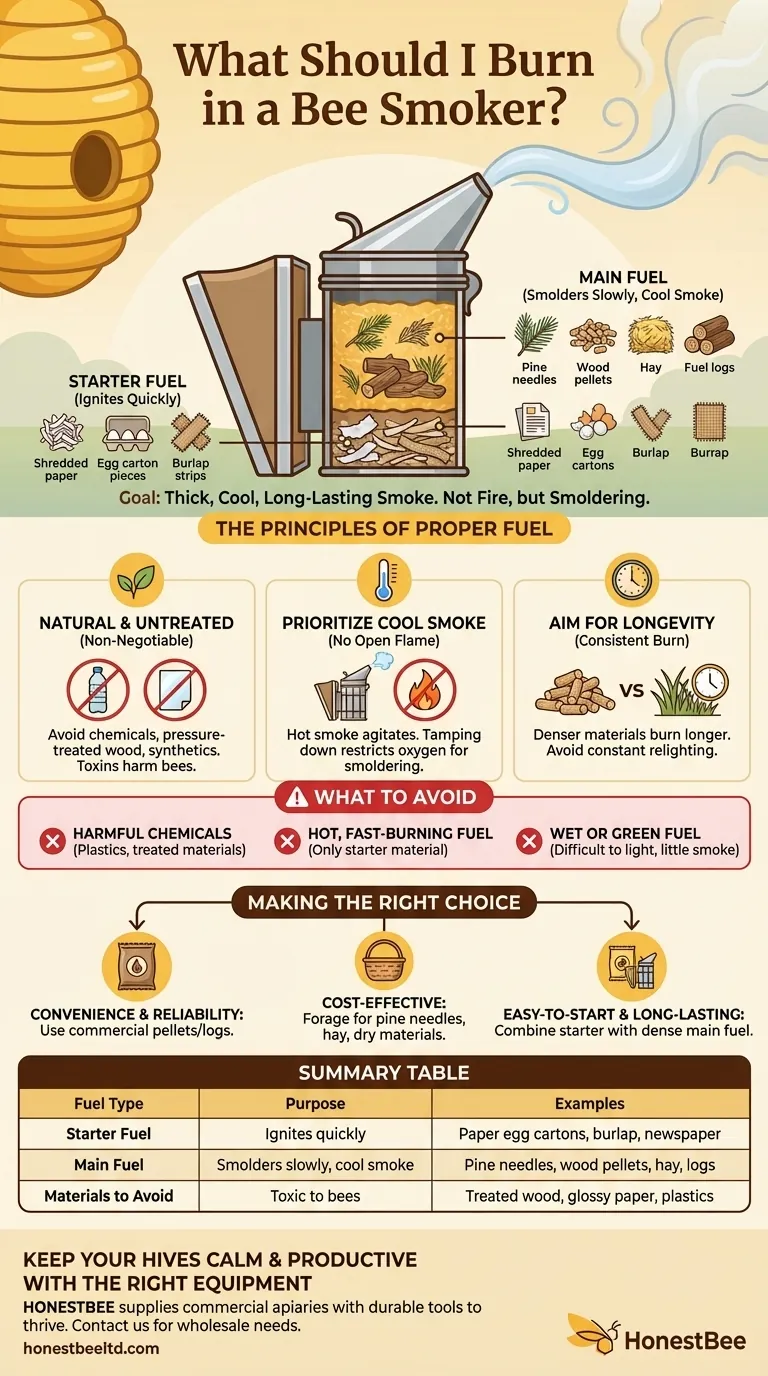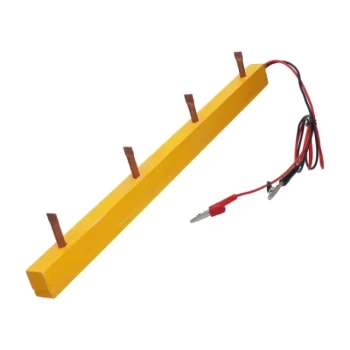The best fuels for a bee smoker are natural, untreated, and dry materials that smolder slowly to produce thick, cool smoke. Excellent options include pine needles, untreated wood shavings, burlap, dried grass, commercial cotton fibers, or specialized fuel pellets. The key is to avoid any synthetic materials or paper treated with chemicals, as these can be toxic to your bees.
The goal is not simply to create fire, but to generate a cool, dense, and long-lasting smoke. This is best achieved by layering a fast-burning starter material at the bottom with a slow-burning main fuel packed on top.

The Principles of Proper Smoker Fuel
A well-managed smoker is a beekeeper's most essential tool for calm hive inspections. The fuel you choose directly impacts its effectiveness. It's a system of two distinct components working together.
The Role of the Starter Fuel
The starter is the kindling. Its only job is to catch a flame easily and create the initial heat needed to ignite your main fuel source.
Starters should be light and burn quickly. Common choices include paper egg cartons, a small ball of newspaper, untreated burlap strips, or even dryer lint.
The Importance of the Main Fuel
This is the workhorse of your smoker. The main fuel must burn slowly and consistently, producing a thick, cool smoke without an open flame.
This fuel is packed on top of the lit starter. Good options are dense, natural materials like pine needles, untreated wood pellets, hay, or commercially prepared smoker logs.
Selecting Safe and Effective Materials
The health of your colony is the top priority. Your fuel choice must reflect that.
Natural and Untreated is Non-Negotiable
Never burn anything that could release harmful chemicals into the hive. This includes pressure-treated wood, glossy or bleached paper, cardboard with glue or tape, and any synthetic fabric.
Stick to materials in their natural state. If you're using burlap, ensure it's from an untreated feed sack, not a craft store bag that might have fire retardants.
Prioritize Cool Smoke
Hot smoke and embers will agitate your bees, defeating the smoker's purpose. The goal is to produce a smoldering fire, not a blazing one.
Properly packing the smoker—tamping down the main fuel—restricts oxygen and helps ensure it smolders rather than burns with an open flame.
Aim for Longevity
A good fuel combination should last for the duration of your hive inspection. Constantly having to relight a smoker is inefficient and distracting.
Denser materials like wood pellets or compressed cotton fibers generally burn longer and more consistently than lighter fuels like dried grass.
Understanding the Trade-offs and What to Avoid
Choosing a fuel involves balancing convenience, cost, and performance. However, some things should always be avoided.
The Danger of Harmful Chemicals
Again, this cannot be overstated. Burning plastics, synthetic twine, or treated paper introduces toxins that can weaken or kill your bees. When in doubt, do not use it.
The Problem with Hot, Fast-Burning Fuel
Using only starter material like egg cartons or newspaper will produce a hot, quick fire. This creates hot smoke that makes bees defensive and requires constant refueling.
The Issue with Wet or Green Fuel
Any fuel you use must be completely dry. Green or damp materials are difficult to light and will produce very little smoke, often going out easily and creating a frustrating experience.
Making the Right Choice for Your Goal
Your ideal fuel depends on what you value most—convenience, cost, or finding a use for natural materials from your own property.
- If your primary focus is convenience and reliability: Use commercial smoker fuel logs or pellets, which are designed to be consistent and long-lasting.
- If your primary focus is cost-effectiveness: Forage for natural, dry materials like pine needles, hay, untreated wood shavings, or long grass clippings.
- If your primary focus is an easy-to-start, long-lasting fire: Combine a reliable starter like a piece of an egg carton with a dense main fuel like wood pellets.
Ultimately, choosing the right fuel is fundamental to practicing calm, safe, and effective beekeeping.
Summary Table:
| Fuel Type | Purpose | Examples |
|---|---|---|
| Starter Fuel | Ignites quickly to light the main fuel | Paper egg cartons, untreated burlap strips, newspaper |
| Main Fuel | Smolders slowly for cool, long-lasting smoke | Pine needles, untreated wood pellets, hay, commercial fuel logs |
| Materials to Avoid | Can be toxic or harmful to bees | Treated wood, glossy paper, plastics, synthetic fabrics |
Keep Your Hives Calm and Productive with the Right Equipment
Mastering your smoker is just one part of successful beekeeping. Equip your operation with reliable, high-quality supplies from HONESTBEE. We supply commercial apiaries and beekeeping equipment distributors with the durable tools they need to thrive.
Contact HONESTBEE today to discuss your wholesale needs and discover how our beekeeping supplies can support the health of your hives and the growth of your business.
Visual Guide

Related Products
- 54-Piece Smoker Fuel Pellets for Beekeeping Beehive Smoker Fuel
- Economy Galvanized Beekeeping Honey Bee Smoker for Wholesale
- Premium Traditional Copper Bee Smoker with Bellows
- Professional Bee Smoker with Elongated Spout and Durable Bellows for Beekeeping
- Stainless Steel Honey Bee Smoker Hive and Honeycomb Smoker for Beekeeping
People Also Ask
- What is the best bee hive smoker fuel? Choose Natural, Slow-Burning Fuel for Calm Bees
- What can I use for bee smoker fuel? Choose Safe, Natural Materials for a Calm Hive
- What are important considerations when choosing smoker fuel? A Guide to Safe, Effective Beekeeping
- What to put in a bee hive smoker? A Guide to Natural, Calming Fuels
- How should you start the fire in a bee smoker? A Step-by-Step Guide for a Calm Hive



















